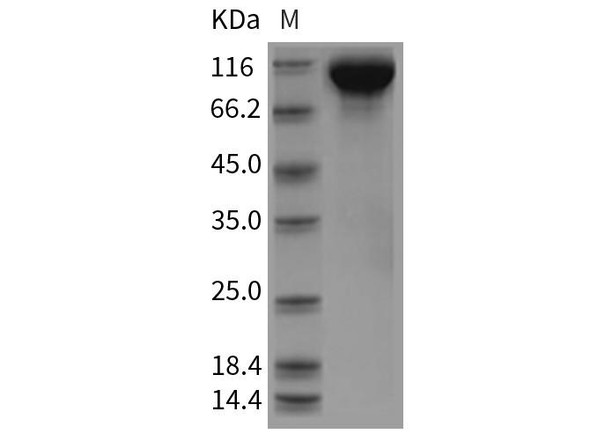| Sequence: | Met1-Gly640 |
| Accession: | P00533 |
| Storage: | Generally, lyophilized proteins are stable for up to 12 months when stored at -20 to -80°C. Reconstituted protein solution can be stored at 4-8°C for 2-7 days. Aliquots of reconstituted samples are stable at < -20°C for 3 months. |
| Shipping: | This product is provided as lyophilized powder which is shipped with ice packs. |
| Formulation: | Lyophilized from sterile PBS, pH 7.4. Normally 5 % - 8 % trehalose, mannitol and 0.01% Tween80 are added as protectants before lyophilization. Please refer to the specific buffer information in the printed manual. |
| Reconstitution: | Please refer to the printed manual for detailed information. |
| Background: | The EGFR subfamily of receptor tyrosine kinases is composed of EGFR; ErbB2; ErbB3 and ErbB4. The EGFR shares 43% - 44% aa sequence identity with the ECD of human EGFR subfamily. All these family members are type I transmembrane glycoproteins with an extracellular ligand binding domain. The extracellular ligand binding domain is containing two cysteine-rich domains separated by a spacer region and a cytoplasmic domain containing a membrane-proximal tyrosine kinase domain. Ligand binding could induce EGFR homodimerization and heterodimerization with ErbB2; resulting in cell signaling; heterodimerization tyrosine phosphorylation and kinase activation. It can bind EGF; amphiregulin; TGF-alpha; betacellulin; epiregulin; HB-EGF; epigen; and so on. Its signaling regulates multiple biological functions including cell proliferation; differentiation; motility; and apoptosis. EGFR can also be recruited to form heterodimers with the ligand-activated ErbB3 or ErbB4. EGFR is overexpressed in different tumors. Several anti-cancer drugs use EGFR as target. |





